Chopper Command
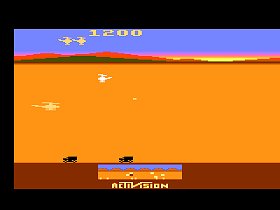
 The Game: You’re a lone attack helicopter jockey in unfriendly desert territory, trying to stop a seemingly endless attacking fleet of enemy jets from bombing a convoy on the ground. (Activision, 1982)
The Game: You’re a lone attack helicopter jockey in unfriendly desert territory, trying to stop a seemingly endless attacking fleet of enemy jets from bombing a convoy on the ground. (Activision, 1982)
Memories: Maybe the best example ever of Activision stealing Atari’s thunder right out from under it, Chopper Command is essentially the same game as Defender, with the singular exception that the enemy is bombing the ground-dwellers instead of trying to abduct them.
Atlantis
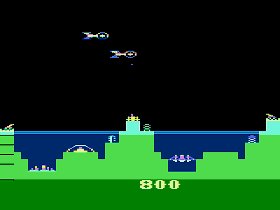 The Game: In a conceptually simple but occasionally very difficult game, you man three fixed artillery batteries defending the advanced underwater city of Atlantis. Alien spaceships pass overhead, and you have to choose your target – and which
The Game: In a conceptually simple but occasionally very difficult game, you man three fixed artillery batteries defending the advanced underwater city of Atlantis. Alien spaceships pass overhead, and you have to choose your target – and which  of the three guns you’re firing – carefully in order to knock them out. Any ships which survive one pass will drop down one level and make another pass. At the lowest level, the ships will begin bombing the city, knocking out habitation domes, power generators, and even your artillery nests. When the final destruction of Atlantis comes at last, one tiny ship escapes into the sky… (Imagic, 1982)
of the three guns you’re firing – carefully in order to knock them out. Any ships which survive one pass will drop down one level and make another pass. At the lowest level, the ships will begin bombing the city, knocking out habitation domes, power generators, and even your artillery nests. When the final destruction of Atlantis comes at last, one tiny ship escapes into the sky… (Imagic, 1982)
 Memories: A pretty simple variation on the Missile Command format, Atlantis starts out exceedingly simple, luring you into a false sense of security. After a while, the game is just about unbeatable. Second only to Activision in its wonderfully crafted games, Imagic made its games extremely colorful, with distinctive graphics and sounds that became an Imagic signature.
Memories: A pretty simple variation on the Missile Command format, Atlantis starts out exceedingly simple, luring you into a false sense of security. After a while, the game is just about unbeatable. Second only to Activision in its wonderfully crafted games, Imagic made its games extremely colorful, with distinctive graphics and sounds that became an Imagic signature.
Attack Of The Timelord!
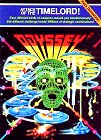 The Game: The game begins as the skull-like face of Spyruss the Deathless (the Timelord of Chaos, no less!) taunts you (well, only if you had the Voice), and then a bunch of pesky spaceships pops out of a vortex to shoot at you. They shoot at you rather a lot. Fortunately, you can shoot back with reckless abandon, but their ammunition – as you ascend into the higher levels of the game – can track you and even, if you don’t destroy their shots in mid-air, crawl along the ground briefly while you head for the opposite side of the screen, neatly trapped for their next volley. (North American Philips, 1982)
The Game: The game begins as the skull-like face of Spyruss the Deathless (the Timelord of Chaos, no less!) taunts you (well, only if you had the Voice), and then a bunch of pesky spaceships pops out of a vortex to shoot at you. They shoot at you rather a lot. Fortunately, you can shoot back with reckless abandon, but their ammunition – as you ascend into the higher levels of the game – can track you and even, if you don’t destroy their shots in mid-air, crawl along the ground briefly while you head for the opposite side of the screen, neatly trapped for their next volley. (North American Philips, 1982)
Memories: One of the last few games to be made for the Odyssey 2, this gem of addictive shooting-gallery fun is obviously heavily derived from the all-time arcade classic Galaga.
Advanced Dungeons & Dragons Cartridge
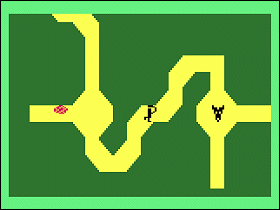 The Game: Your quest begins as you set out from the safety of home to look for adventure in mountainous caverns. When you wander into the dungeons and caverns, your view zooms in to the maze your adventurer is exploring, complete with treasures to collect and deadly dangers to duel. (Mattel Electronics, 1982)
The Game: Your quest begins as you set out from the safety of home to look for adventure in mountainous caverns. When you wander into the dungeons and caverns, your view zooms in to the maze your adventurer is exploring, complete with treasures to collect and deadly dangers to duel. (Mattel Electronics, 1982)
Memories: Combining sword-and-sorcery – traditionally the territory of paper-and-dice role playing games – with video game action has been one of the more inspired mash-ups to come from the golden age of video games. As combinations go, it was almost inevitable – with Dungeons & Dragons being more geeky than mainstream in the 1970s, it was an activity with which game programmers – another geeky crowd – were likely to be acquainted. With all of that crossover going on, it was therefore inevitable that someone, presumably whoever had deep enough pockets to license the title and game elements, would eventually produce an official video game.
Zoo Keeper
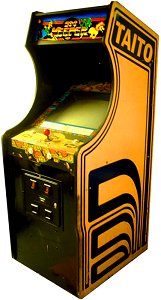
 The Game: You are Zeke the Zoo Keeper, and apparently you’re asleep on the job because the critters are breaking free! Your job is to nab them with a net which appears occasionally (a la Donkey Kong’s hammer), and otherwise avoid the stampeding animals until you can wall them back into their cage. (It seems odd, caging the animals with bricks – wouldn’t that make them rather difficult to feed or show to the public?) Then you keep going until you reach Zeke’s girlfriend Zelda. (Taito, 1982)
The Game: You are Zeke the Zoo Keeper, and apparently you’re asleep on the job because the critters are breaking free! Your job is to nab them with a net which appears occasionally (a la Donkey Kong’s hammer), and otherwise avoid the stampeding animals until you can wall them back into their cage. (It seems odd, caging the animals with bricks – wouldn’t that make them rather difficult to feed or show to the public?) Then you keep going until you reach Zeke’s girlfriend Zelda. (Taito, 1982)
Memories: Taito may have jumped the gun a little on their publicity campaign for Zoo Keeper, which touted Zeke and his girlfriend Zelda (no, not Nintendo’s Zelda) as the next wave of franchise video game characters, right up there with Mario and Pac-Man and family. Instead, Zeke and Zelda wound up in the same class as Mappy and Venture‘s Winky – the victims of the video arcade’s equivalent of the old Hollywood stand-by line, “Don’t call us – we’ll call you.”
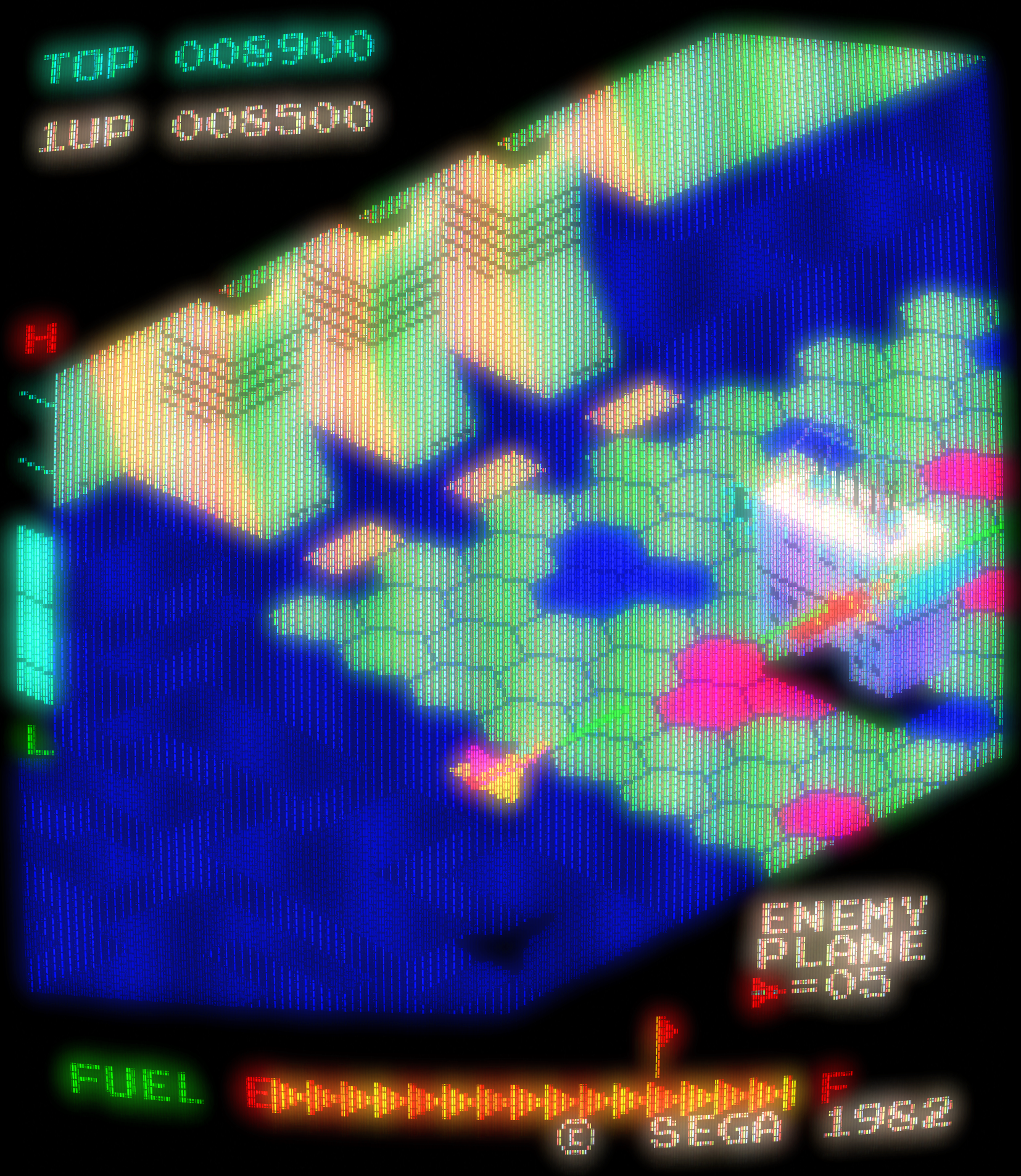
Zaxxon
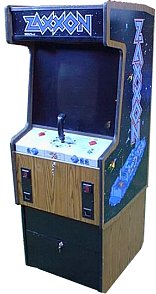 The Game: As the pilot of a lone fighter infiltrating a spaceborne fortress (vaguely inspired by the Death Star trench scenes in Star Wars), your mission is simple – survive long enough to vanquish the evil Zaxxon robot hidden deep within the fortress, and take out as much of the defenses as you can in the meantime. (Sega, 1982)
The Game: As the pilot of a lone fighter infiltrating a spaceborne fortress (vaguely inspired by the Death Star trench scenes in Star Wars), your mission is simple – survive long enough to vanquish the evil Zaxxon robot hidden deep within the fortress, and take out as much of the defenses as you can in the meantime. (Sega, 1982)
Memories: Zaxxon drastically changed the nature of side-scrolling shooter games by introducing a somewhat 3-D perspective to the game. Not only were altitude and forward motion taken into account, but you could also move side to side, banking, diving, and gaining altitude. Bearing in mind that Zaxxon was the first game to feature this kind of movement, its experimental nature and great graphics occasionally got in the way of the player’s attempt to ascertain exactly where he was in the playing field. Also, some of the actual obstacles in your path were indistinguishable from the harmless scrolling background.
Wacko
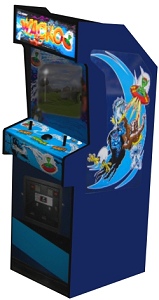
 The Game: Kozmik Krooz’r is back, floating around a desolate landscape in his tiny saucer and blasting away at the menacing denizens of the planet. By shooting two identical creatures, he can eliminate them; failing to match his first target with his next one will either release both creatures or, in later levels, create mix-and-match mutations that will prove to be even more difficult to get rid of. By eliminating all of the creatures on the screen, Krooz’r cruises to the next level; if any of the creatures come in contact with him, he loses a life. (Midway, 1982)
The Game: Kozmik Krooz’r is back, floating around a desolate landscape in his tiny saucer and blasting away at the menacing denizens of the planet. By shooting two identical creatures, he can eliminate them; failing to match his first target with his next one will either release both creatures or, in later levels, create mix-and-match mutations that will prove to be even more difficult to get rid of. By eliminating all of the creatures on the screen, Krooz’r cruises to the next level; if any of the creatures come in contact with him, he loses a life. (Midway, 1982)
Memories: Video game history is rife with specimens of characters who struck somebody as being promising enough that an attempt was made to bring an entire franchise into being on willpower alone. From Exidy’s promise that Venture‘s “Winky” would star in later games (he didn’t) to Midway’s duo of Kozmik Krooz’r games, these also-ran characters are kind of like pixellated reality talent show wanna-bes, strutting their stuff for the arcade’s equivalent of 15 minutes of fame before the gaming public voted with their quarters.
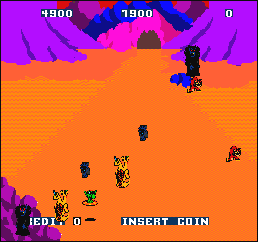
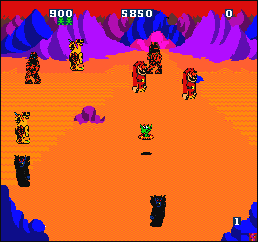
Kozmik Krooz’r appeared in two games released at roughly the same time by Midway: Wacko and the eponymous Kozmik Krooz’r. Both games were built around a gimmick. Kozmik Krooz’r sported a miniature model of a flying saucer above the screen, and the game’s action revolved around that saucer’s presence; Wacko, on the other hand, had one of the most unique cabinets designed for a coin-op to date: the entire cabinet, marquee, control panel and all, was lopsided, sloping downward from left to right. Whether or not gamers got the joke, however, is another thing entirely. (The answer may well lie in the fact that Krooz’r didn’t appear in any further games.)
With the dark look of the classic arcade of the 1970s giving way to Chuck E. Cheese-inspired day-glo friendliness in the ’80s, Midway was simiarly aiming to make a relatively friendly game with Wacko, and it’s an interesting twitch-gaming experience grafted onto an almost educational  concept (shape/pattern matching). As interesting as the “wack”-ed out cabinet was, one wonders if it actually lured enough gamers in to make the break with tradition worthwhile…or if it hurt Wacko‘s chances instead.
concept (shape/pattern matching). As interesting as the “wack”-ed out cabinet was, one wonders if it actually lured enough gamers in to make the break with tradition worthwhile…or if it hurt Wacko‘s chances instead.
Xevious
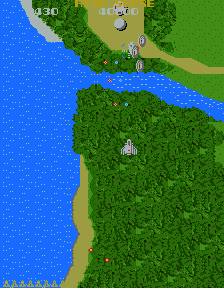 The Game: As the commander of a sleek Solvalou fighter, you’re deep into enemy territory, shooting their disc-shaped fighters out of the sky, bombing ground installations and artillery nests, bombing tanks, and trying to destroy the mothership. As you progress further behind enemy lines, heavier aircraft and more versatile and
The Game: As the commander of a sleek Solvalou fighter, you’re deep into enemy territory, shooting their disc-shaped fighters out of the sky, bombing ground installations and artillery nests, bombing tanks, and trying to destroy the mothership. As you progress further behind enemy lines, heavier aircraft and more versatile and  deadly ground-based defenses become the norm. Also look out for tumbling airborne mirrors – they’re impervious to your fire, but you’re toast if you fly right into them. (Atari [under license from Namco], 1982)
deadly ground-based defenses become the norm. Also look out for tumbling airborne mirrors – they’re impervious to your fire, but you’re toast if you fly right into them. (Atari [under license from Namco], 1982)
Memories: A very cool game indeed, Xevious was extremely challenging and quite nice to look at as well. The controls were smooth, and you really did have a full range of control over where your fighter was on the screen.
Turtles
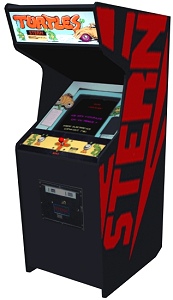 The Game: You are the Mama Turtle. Your helpless KidTurtles are stuck in a high-rise building, hiding from mean and hungry beetles. The beetles change colors in accordance with their speed and ferocity, from less aggressive green and blue beetles to fast, furious yellow and red beetles. Mama Turtle has to evade the beetles (which are deadly to touch at all times) and touch the mystery squares throughout the maze. The squares could reveal another beetle, or they could reveal one of the KidTurtles. When Mama Turtle picks up a KidTurtle, a safe house appears – usually all the way across the maze – and she must deposit the KidTurtles in the safe house, one at a time. Mama Turtle’s only recourse against the beetles is to lay “bombs” in the maze. Each bomb – and there can only be one on screen at a time – will reduce the first beetle that hits it back to the lowest speed/danger level, buying Mama Turtle a little time. (Mama Turtle can pass over her own bombs harmlessly.) The catch? You only start out with three bombs (is anyone else drawing some grim biological anologies to what Mama Turtle’s “bombs” might be at this point?), and you can replenish your supply of bombs only by running over an occasional flashing symbol which appears at the precise center of the maze…which is usually the most dangerous spot on the screen. Clearing a maze of KidTurtles allows you to climb to the next floor of the building and start anew. (Stern [under license from Konami], 1982)
The Game: You are the Mama Turtle. Your helpless KidTurtles are stuck in a high-rise building, hiding from mean and hungry beetles. The beetles change colors in accordance with their speed and ferocity, from less aggressive green and blue beetles to fast, furious yellow and red beetles. Mama Turtle has to evade the beetles (which are deadly to touch at all times) and touch the mystery squares throughout the maze. The squares could reveal another beetle, or they could reveal one of the KidTurtles. When Mama Turtle picks up a KidTurtle, a safe house appears – usually all the way across the maze – and she must deposit the KidTurtles in the safe house, one at a time. Mama Turtle’s only recourse against the beetles is to lay “bombs” in the maze. Each bomb – and there can only be one on screen at a time – will reduce the first beetle that hits it back to the lowest speed/danger level, buying Mama Turtle a little time. (Mama Turtle can pass over her own bombs harmlessly.) The catch? You only start out with three bombs (is anyone else drawing some grim biological anologies to what Mama Turtle’s “bombs” might be at this point?), and you can replenish your supply of bombs only by running over an occasional flashing symbol which appears at the precise center of the maze…which is usually the most dangerous spot on the screen. Clearing a maze of KidTurtles allows you to climb to the next floor of the building and start anew. (Stern [under license from Konami], 1982)
Memories: Turtles is among the most obscure exponents of the maze chase format to hit the arcade in the early ’80s. I think I saw – maybe – one Turtles arcade game in my life, and it was only there for a few weeks. Actually, though, it’s not a bad game.
Tutankham
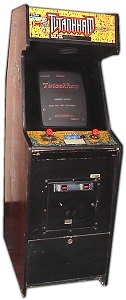 The Game: As an intrepid, pith-helmeted explorer, you’re exploring King Tut’s catacombs, which are populated by a variety of killer bugs, birds, and other nasties. You’re capable of firing left and right, but not vertically – so any oncoming threats from above or below must be outrun or avoided. Warp portals will instantly whisk you away to other parts of the maze (though this doesn’t necessarily mean safer). Gathering all of the treasures and keys will allow you to open the vault at the end of each level…which leads to the next, and even more difficult level. It’s like The Mummy, only much more entertaining. (Stern, 1982)
The Game: As an intrepid, pith-helmeted explorer, you’re exploring King Tut’s catacombs, which are populated by a variety of killer bugs, birds, and other nasties. You’re capable of firing left and right, but not vertically – so any oncoming threats from above or below must be outrun or avoided. Warp portals will instantly whisk you away to other parts of the maze (though this doesn’t necessarily mean safer). Gathering all of the treasures and keys will allow you to open the vault at the end of each level…which leads to the next, and even more difficult level. It’s like The Mummy, only much more entertaining. (Stern, 1982)
Memories: Konami/Stern’s 1982 maze shooter was about as different from its antecedents (Berzerk and Frenzy) as possible, and was still fun. The one thing that always got people in the arcades, especially on their first attempt at playing the game, was the fact that it was impossible to shoot vertically – firing could be controlled by a second joystick limited to left-right movement.
Super Zaxxon
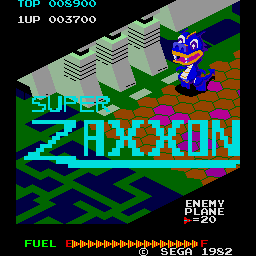 The Game: That armed-to-the-teeth spaceborne fortress is back – and so are you, because you’re (of course) the only space pilot who can take it on. This time, however, you’ll be flying through the trench-like space station faster, the automated missiles and gun turrets will attack you more quickly and aggressively, and instead of flying through space between levels, this time you shoot through a tightly-enclosed tunnel at bat-out-of-hell speeds – trying to battle enemy fighters as well as minelaying hovercraft which drop indestructible mines into your path. And perhaps the biggest surprise of all? Whereas the boss waiting for you in Zaxxon‘s fortress was a big robot, this one’s an animè-cute dragon – and it’ll still kick your ass if you don’t blow it up first. (Sega, 1982)
The Game: That armed-to-the-teeth spaceborne fortress is back – and so are you, because you’re (of course) the only space pilot who can take it on. This time, however, you’ll be flying through the trench-like space station faster, the automated missiles and gun turrets will attack you more quickly and aggressively, and instead of flying through space between levels, this time you shoot through a tightly-enclosed tunnel at bat-out-of-hell speeds – trying to battle enemy fighters as well as minelaying hovercraft which drop indestructible mines into your path. And perhaps the biggest surprise of all? Whereas the boss waiting for you in Zaxxon‘s fortress was a big robot, this one’s an animè-cute dragon – and it’ll still kick your ass if you don’t blow it up first. (Sega, 1982)
Memories: Originally sold as a conversion kit so arcade operators could freshen up their year-old Zaxxon machines, Super Zaxxon really did nothing more than swap out the graphics set and increased the speed of the game phenomenally. If you thought Zaxxon was a breeze, this game will wake you up.
Super Pac-Man
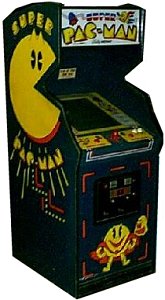
 The Game: Once again, Pac-Man roams the maze, pursued by four colorful ghosts. But instead of dots, this maze is peppered with other goodies, ranging from the usual fruits (apples, bananas, etc.) to donuts, cake, and burgers. And in addition to the traditional four “power pellets” in each corner of the screen, there are two green “super power pellets” per screen, which give the mighty yellow one the power to fly over the monsters’ heads and to break down doors that confine some of the yummy treats in the maze. (Bally/Midway [under license from Namco], 1982)
The Game: Once again, Pac-Man roams the maze, pursued by four colorful ghosts. But instead of dots, this maze is peppered with other goodies, ranging from the usual fruits (apples, bananas, etc.) to donuts, cake, and burgers. And in addition to the traditional four “power pellets” in each corner of the screen, there are two green “super power pellets” per screen, which give the mighty yellow one the power to fly over the monsters’ heads and to break down doors that confine some of the yummy treats in the maze. (Bally/Midway [under license from Namco], 1982)
Memories: The earliest of several very strange departures from the successful Pac-Man formula, Super Pac-Man was still a fun and, more often than not, fondly remembered game, even if it was ever so slightly baffling. Admittedly, even the mention above of Pac-Man flying is my own interpretation, based on the Pac-Man-going-on-Superman artwork on the arcade cabinet. It’s a bizarre little concept!
Reactor
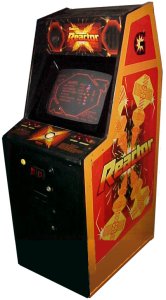 The Game: In a bizarre combination of pinball, zero gravity, and nuclear physics, you pilot your “ship” around a reactor chamber, trying to eliminate rogue radioactive particles (which are about the same size as your ship). Anything touching the outer walls of the chamber will be destroyed, including your on-screen alter ego. Two pairs of five rods can be used to cool down the ever-expanding nuclear reaction at the center of the screen, but you can only push the rods in by bumping the particle into them head-on. Trapping particles in either of two cul-de-sacs in the upper right and lower left corners of the playing field will earn you bonus points, and the best way to accomplish this is to plant one of your limited number of decoys at the entrance to one of the smaller areas. In early levels, you can keep your back to the reactor and hug it as you bounce the particles off of it, but in later levels, the reactions are exposed and become just as deadly to you as to the walls are. (Gottlieb, 1982)
The Game: In a bizarre combination of pinball, zero gravity, and nuclear physics, you pilot your “ship” around a reactor chamber, trying to eliminate rogue radioactive particles (which are about the same size as your ship). Anything touching the outer walls of the chamber will be destroyed, including your on-screen alter ego. Two pairs of five rods can be used to cool down the ever-expanding nuclear reaction at the center of the screen, but you can only push the rods in by bumping the particle into them head-on. Trapping particles in either of two cul-de-sacs in the upper right and lower left corners of the playing field will earn you bonus points, and the best way to accomplish this is to plant one of your limited number of decoys at the entrance to one of the smaller areas. In early levels, you can keep your back to the reactor and hug it as you bounce the particles off of it, but in later levels, the reactions are exposed and become just as deadly to you as to the walls are. (Gottlieb, 1982)
Memories: A decidedly weird but incredibly addictive game. You may find yourself spending ages on it before you know it, and getting better and better at the game. This is a game which would probably be a hit in a graphically updated edition – providing the game play was left as is. Then again, adding detailed graphics would probably rob Reactor of a lot of its mystique.
Pengo
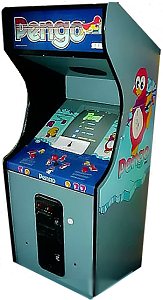 The Game: As a cute, fuzzy, harmless little penguin, you roam around an enclosed maze of ice blocks. If this sounds too good to be true – especially for a polar-dwelling avian life form – that’s because you’re not the only critter waddling around in the frozen tundra. Killer Sno-Bees chase little Pengo around the ice, and if they catch up to him and sting him, it’ll cost you a life. But your little flightless waterfowl isn’t completely defenseless. Pengo can push blocks of ice out of the maze, changing the configuration of the playing field and squashing Sno-Bees with a well-timed shove. Clearing the field of Sno-Bees allows you to advance to the next level. (Sega, 1982)
The Game: As a cute, fuzzy, harmless little penguin, you roam around an enclosed maze of ice blocks. If this sounds too good to be true – especially for a polar-dwelling avian life form – that’s because you’re not the only critter waddling around in the frozen tundra. Killer Sno-Bees chase little Pengo around the ice, and if they catch up to him and sting him, it’ll cost you a life. But your little flightless waterfowl isn’t completely defenseless. Pengo can push blocks of ice out of the maze, changing the configuration of the playing field and squashing Sno-Bees with a well-timed shove. Clearing the field of Sno-Bees allows you to advance to the next level. (Sega, 1982)
Memories: This is almost a painfully cute game. Cute, fuzzy characters (both good and bad) waddle around the screen, and even if Pengo gets caught by the Sno-Bees, his little dance of defeat is cute. If you win a few levels, a multicolored lineup of penguins do a little Rockettes-style dance for you. But despite the tooth-rotting overabundance of sweetness, Pengo was a very addictive little game.
Pac-Man Plus
 The Game: As a round yellow creature consisting of a mouth and nothing else, you maneuver around a relatively simple maze, gobbling small dots (10 points) and evading four colorful monsters who can eat you on contact. In four corners of the screen, large flashing dots (50 points) enable you to turn the tables and eat the monsters for a brief period for an escalating score (200, 400, 800 and 1600 points). Periodically, assorted items appear near the center of the maze, and you can consume these for additional points as well. The monsters, once eaten, return to their home base in ghost form and return to chase you anew. If cleared of dots, the maze refills and the game starts again, but just a little bit faster… (Bally/Midway, 1982)
The Game: As a round yellow creature consisting of a mouth and nothing else, you maneuver around a relatively simple maze, gobbling small dots (10 points) and evading four colorful monsters who can eat you on contact. In four corners of the screen, large flashing dots (50 points) enable you to turn the tables and eat the monsters for a brief period for an escalating score (200, 400, 800 and 1600 points). Periodically, assorted items appear near the center of the maze, and you can consume these for additional points as well. The monsters, once eaten, return to their home base in ghost form and return to chase you anew. If cleared of dots, the maze refills and the game starts again, but just a little bit faster… (Bally/Midway, 1982)
Memories: Admittedly this wasn’t an especially unique game, but it does have an interesting history.
Mr. Do!
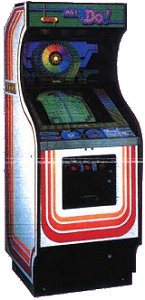 The Game: As the clownlike elfin dweller of a magic garden, you must avoid or do away with a bunch of nasty critters who are after you, while gobbling up as much yummy fruit as you can. (Taito [under license from Universal], 1982)
The Game: As the clownlike elfin dweller of a magic garden, you must avoid or do away with a bunch of nasty critters who are after you, while gobbling up as much yummy fruit as you can. (Taito [under license from Universal], 1982)
Memories: Mr. Do! is a curious chicken-or-the-egg case. Many elements of Mr. Do! are very similar to Dig Dug. However, Mr. Do! is a much more challenging game.
It was also one of the earliest entries from Universal, a company – unrelated to the Hollywood studio of the same name – whose business model appealed to arcade owners, but became a bugbear for competing arcade game manufacturers. Though Mr. Do! was sold as a standalone cabinet licensed through Taito, Universal’s primary product line was “kit games” – a kit with a new circuit board, marquee and cabinet artwork that could transform any cabinet with similar controls into Universal’s latest offering.
Moon Patrol
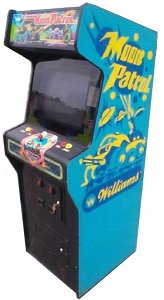
 The Game: Driving an agile, armed moon buggy across the lunar surface, you must jump over craters and land mines, shoot large boulders (some occasionally mobile) out of your way, and try not to be on the receiving end of hostile fire from alien ships that try to strafe you. Some of the ships, which look very suspiciously like the triangle-of-spheres enemy ships from Gyruss, can even bomb the moon and make new craters for you to jump over – which may put you right into their line of fire. Later on, you also get to blast away tanks and dodge pesky jet cars which “tailgate” and then try to ram you. (Williams Electronics [under license from IREM], 1982)
The Game: Driving an agile, armed moon buggy across the lunar surface, you must jump over craters and land mines, shoot large boulders (some occasionally mobile) out of your way, and try not to be on the receiving end of hostile fire from alien ships that try to strafe you. Some of the ships, which look very suspiciously like the triangle-of-spheres enemy ships from Gyruss, can even bomb the moon and make new craters for you to jump over – which may put you right into their line of fire. Later on, you also get to blast away tanks and dodge pesky jet cars which “tailgate” and then try to ram you. (Williams Electronics [under license from IREM], 1982)
Memories: Moon Patrol is a cool game with an actual goal, and with that in mind, it shares a common trait with SNK’s Fantasy – a “continue game” feature which allows you to continue from your last position for just 25 cents more.
Loco Motion
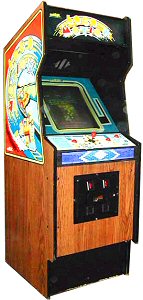 The Game: A train scoots around a twisty maze of tiles representing overpasses, turns, straightaways and terminals. One portion of the maze is blank, and a train will be lost if it hits that blank tile. Using the joystick, you move the blank tile and one adjacent tile around on the map – even if the train is in transit on that tile – in an effort to keep it moving around the maze, picking up passengers. (Passengers that the train can reach are smiley faces; passengers cut off from the main route are frowning.) If any passengers are cut off for an extended period of time, a monster begins wandering that route, and it’ll cost you a train if it comes in contact with your train. You may have to outrun it with the “speed” button in order to pick up the last passengers and clear the level to move on to a bigger maze. (Centuri (under license from Konami), 1982)
The Game: A train scoots around a twisty maze of tiles representing overpasses, turns, straightaways and terminals. One portion of the maze is blank, and a train will be lost if it hits that blank tile. Using the joystick, you move the blank tile and one adjacent tile around on the map – even if the train is in transit on that tile – in an effort to keep it moving around the maze, picking up passengers. (Passengers that the train can reach are smiley faces; passengers cut off from the main route are frowning.) If any passengers are cut off for an extended period of time, a monster begins wandering that route, and it’ll cost you a train if it comes in contact with your train. You may have to outrun it with the “speed” button in order to pick up the last passengers and clear the level to move on to a bigger maze. (Centuri (under license from Konami), 1982)
Memories: A very minor star in the constellation of early Konami coin-ops (Konami also being responsible for Frogger, Time Pilot and Gyruss), Loco Motion is actually a variation on a very old theme: the 2-D sliding tile puzzle.
Liberator
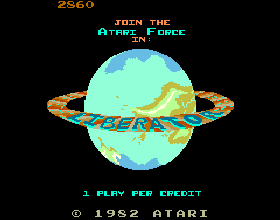
 The Game: So, you’ve always wanted to pilot the Liberator? If you’re talking about the Atari Force’s trusty little flotilla of space fighters, you’re in luck. Your four fighters take up positions at the four corners of the screen, and you use a trackball to aim a cursor; hitting the fire button fires the weapons of the ship nearest the cursor. Basically, the “Malagon Army,” according to the introductory screen, has pulled off a strategic (to say nothing of logistical) coup in invading the entire galaxy – and you and your four fighters are supposed to free…well…the entire galaxy. Hopefully you packed a lunch. At the beginning of your mission, you’re trying to pick off Malagon scout ships in deep space. You then move on to a succession of planets where you have to take out missiles (and the ground bases that hurl them at you) and enemy satellites. Letting a missile through can begin to cost you ships quickly, and when all four fighters are fragged, you’re finished. (Atari, 1982)
The Game: So, you’ve always wanted to pilot the Liberator? If you’re talking about the Atari Force’s trusty little flotilla of space fighters, you’re in luck. Your four fighters take up positions at the four corners of the screen, and you use a trackball to aim a cursor; hitting the fire button fires the weapons of the ship nearest the cursor. Basically, the “Malagon Army,” according to the introductory screen, has pulled off a strategic (to say nothing of logistical) coup in invading the entire galaxy – and you and your four fighters are supposed to free…well…the entire galaxy. Hopefully you packed a lunch. At the beginning of your mission, you’re trying to pick off Malagon scout ships in deep space. You then move on to a succession of planets where you have to take out missiles (and the ground bases that hurl them at you) and enemy satellites. Letting a missile through can begin to cost you ships quickly, and when all four fighters are fragged, you’re finished. (Atari, 1982)
Memories: An interesting game, Liberator, even if it breaks my heart by teasing me with that name and then having nothing to do with the starship of the same name from the 70s BBC space opera Blake’s 7. (Actually, it would almost make as much sense to adapt this game to that storyline as it did to try to attach it to the Atari Force comic books, which were shipped with numerous Atari VCS cartridges but had no prior presence in the arcade.)
Kangaroo
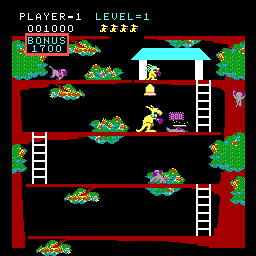 The Game: As a mama marsupial trying to save your baby from many malignant marauding monkeys, you go on a rescue mission that involves climbing through many, many levels of the monkeys’ treehouse village, punching primates, dodging airborne apples, grabbing various fruit items along the way (considering the abundance of apples, strawberries, cherries and bananas, one can only assume these are Pac-Man’s table leavings), and avoiding the big, purple boxing-glove-stealing ape. (Atari [under license from Sun], 1982)
The Game: As a mama marsupial trying to save your baby from many malignant marauding monkeys, you go on a rescue mission that involves climbing through many, many levels of the monkeys’ treehouse village, punching primates, dodging airborne apples, grabbing various fruit items along the way (considering the abundance of apples, strawberries, cherries and bananas, one can only assume these are Pac-Man’s table leavings), and avoiding the big, purple boxing-glove-stealing ape. (Atari [under license from Sun], 1982)
Memories: While some American coin-op game companies jumped on the license-from-Japan bandwagon and scored big early on, such as Midway (who imported Space Invaders and Pac-Man from two different Japanese game makers), Atari was a long-time holdout. Atari’s internal coin-op division was its own internal hit machine, and that simplified things when the consumer division needed hot new arcade titles to translate to the company’s home game consoles.
Jungle King / Jungle Hunt
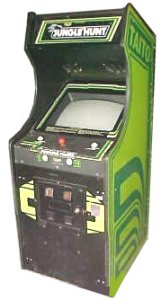 The Game: You are the king of the jungle! Swinging from vine to vine! Swimming through crocodile-infested waters! Jumping and ducking huge rolling boulders! And vanquishing spear-weilding natives to rescue the damsel! (Taito, 1982)
The Game: You are the king of the jungle! Swinging from vine to vine! Swimming through crocodile-infested waters! Jumping and ducking huge rolling boulders! And vanquishing spear-weilding natives to rescue the damsel! (Taito, 1982)
 Memories: Not that Jungle King was an incredibly simple game – the above description is supposed to be a little bit humorous, if oversimplified – but Jungle King‘s most infamous footnote in video game history is the lawsuit that it drew. The original Jungle King game opened with the sound of a sampled “Tarzan yell” – and the estate of Edgar Rice Burroughs was not amused.
Memories: Not that Jungle King was an incredibly simple game – the above description is supposed to be a little bit humorous, if oversimplified – but Jungle King‘s most infamous footnote in video game history is the lawsuit that it drew. The original Jungle King game opened with the sound of a sampled “Tarzan yell” – and the estate of Edgar Rice Burroughs was not amused.
Front Line
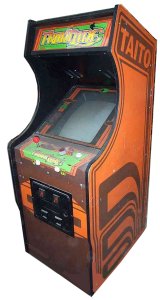 The Game: In a very genteel and almost inappropriately cute game about armored combat, you’re a lone footsoldier fighting your way through a platoon of enemy troops, trying to take out as many of them as you can until you find your way to a handy empty tank. (Nice of the enemy to allow your government to plant friendly tanks behind their borders, isn’t it?) But once you man your own tank, enemy tanks surround you. If one of them hits your tank, you have mere seconds to bail out before your tank blows, and you have to dodge cannon fire until you can find another friendly tank to commandeer. Finally, after crossing hazardous stretches of desert and fighting off entire battallions of enemy tanks, you’re en route to the final confrontation, a showdown with the enemy’s armored headquarters… (Taito, 1982)
The Game: In a very genteel and almost inappropriately cute game about armored combat, you’re a lone footsoldier fighting your way through a platoon of enemy troops, trying to take out as many of them as you can until you find your way to a handy empty tank. (Nice of the enemy to allow your government to plant friendly tanks behind their borders, isn’t it?) But once you man your own tank, enemy tanks surround you. If one of them hits your tank, you have mere seconds to bail out before your tank blows, and you have to dodge cannon fire until you can find another friendly tank to commandeer. Finally, after crossing hazardous stretches of desert and fighting off entire battallions of enemy tanks, you’re en route to the final confrontation, a showdown with the enemy’s armored headquarters… (Taito, 1982)
Memories: Front Line was a really fun and addictive game to play, and was always one of my favorites. I didn’t ever give a thought, at the time, that this game really keeps the player’s vision of warfare from delving into the bloody or the unpleasant, and all the characters – even those octagonal, roly-poly little tanks – are really cute.
Frenzy
 The Game: You’re back in the maze, but this time, the stakes are increased, the danger is increased, and your strategic options are only slightly increased. Touching the walls, the robots, the robots’ laser blasts, or even your own ricocheted lasers are deadly. And of course, the inevitable appearance by Evil Otto is also deadly. However, you can temporarily repel the smiley little bugger by blasting him until his grin turns into the frown – but he will reappear mere seconds later, moving much faster every time he must retreat and reappear – so you’re not doing yourself any favors. If you enter a generator room, you can halt all the robots in their tracks by penetrating the walls surrounding the generator and blasting it. “Beaded” walls can be eaten away, bit by bit, by laser fire from anyone who shoots it, while solid walls will ricochet lasers around until they hit something – which could mean a death trap for you. (Stern, 1982)
The Game: You’re back in the maze, but this time, the stakes are increased, the danger is increased, and your strategic options are only slightly increased. Touching the walls, the robots, the robots’ laser blasts, or even your own ricocheted lasers are deadly. And of course, the inevitable appearance by Evil Otto is also deadly. However, you can temporarily repel the smiley little bugger by blasting him until his grin turns into the frown – but he will reappear mere seconds later, moving much faster every time he must retreat and reappear – so you’re not doing yourself any favors. If you enter a generator room, you can halt all the robots in their tracks by penetrating the walls surrounding the generator and blasting it. “Beaded” walls can be eaten away, bit by bit, by laser fire from anyone who shoots it, while solid walls will ricochet lasers around until they hit something – which could mean a death trap for you. (Stern, 1982)
Memories: I can’t even begin to estimate how many orders of magnitude harder Frenzy is than its inspiration, Stern’s mega-hit Berzerk. There are many times when you have approximately a second – before the characters on the screen begin moving – to assess your strategic situation, which usually isn’t too promising, often placing you in a triangulation of crossfire from three or four different robots that you haven’t even begun to figure out how to reach.
Donkey Kong Junior
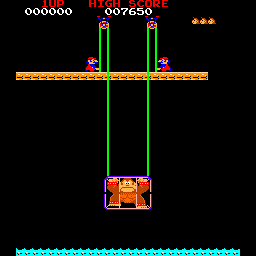 The Game: Mario, in his second-ever videogame appearance, has Donkey Kong in captivity, and it’s up to Donkey Kong Jr. to rescue his dad by scaling vines and chains, avoiding nasty-toothed traps and pesky birds, and reaching the key to free the great ape from Mario’s clutches. (Nintendo, 1982)
The Game: Mario, in his second-ever videogame appearance, has Donkey Kong in captivity, and it’s up to Donkey Kong Jr. to rescue his dad by scaling vines and chains, avoiding nasty-toothed traps and pesky birds, and reaching the key to free the great ape from Mario’s clutches. (Nintendo, 1982)
Memories: Donkey Kong Junior was a really cool game, because it added new ideas to the same general concept as Donkey Kong, resulting in a game that those proficient at the original game wouldn’t find difficult to learn. It was also unique in that the character that you played in Donkey Kong – the hero – was suddenly the villain in this game, and you were out to defeat him.
Buck Rogers: Planet Of Zoom
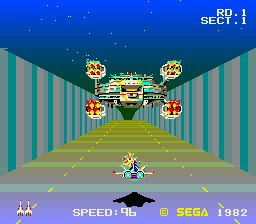 The Game: Zoom being the operative word here, your mission – as space hero Buck Rogers – is to fly in close quarters with all kinds of enemy ships, landers and structures, fending off their attacks, and generally staying alive as long as possible. Obligatory robot wisecracks and utterances of “beedy-beedy-beedy” not included. (Sega, 1982)
The Game: Zoom being the operative word here, your mission – as space hero Buck Rogers – is to fly in close quarters with all kinds of enemy ships, landers and structures, fending off their attacks, and generally staying alive as long as possible. Obligatory robot wisecracks and utterances of “beedy-beedy-beedy” not included. (Sega, 1982)
Memories: Debuting in arcades a mere two years after the exit of the popular but troubled Buck Rogers TV series, Sega’s coin-op had no real connection with it. If anything, the enemy ships and architecture in Planet Of Zoom are a bit more art deco, suggesting the comic book roots of Buck Rogers. Sega later ported the game to a few home consoles, and while the player’s ship in those games seemed to hearken back to the sleek fighters of the TV series, it was more likely a case of simplifying the arcade game’s fancy rocketship.
Black Widow
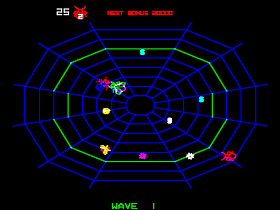
 The Game: You’re a spider whose web seems to be a popular hangout for any number of flies who seem to have an aversion to getting caught there. So you’re left with the only option nature leaves open to a spider in this scenario: you shoot your prey down and eat the yummy grubsteak that’s left behind! Some bugs will have the whaudacity to lay their eggs in your web, which you can either push off the edge (a risky trick depending on how “developed” some of the eggs are) or wait to hatch into more bugs that you can shoot down. Beware of “grenade bugs” which destroy everything within a certain radius around them when you shoot them; they may take out other adversaries as they go, or destroy you if you’re too close. (Atari, 1982)
The Game: You’re a spider whose web seems to be a popular hangout for any number of flies who seem to have an aversion to getting caught there. So you’re left with the only option nature leaves open to a spider in this scenario: you shoot your prey down and eat the yummy grubsteak that’s left behind! Some bugs will have the whaudacity to lay their eggs in your web, which you can either push off the edge (a risky trick depending on how “developed” some of the eggs are) or wait to hatch into more bugs that you can shoot down. Beware of “grenade bugs” which destroy everything within a certain radius around them when you shoot them; they may take out other adversaries as they go, or destroy you if you’re too close. (Atari, 1982)
Memories: Black Widow is a fun number which smacks of an attempt to do Robotron: 2084 in vector graphics. It’s also one of the handful of Atari arcade games sporting the color vector monitor, which was prone to numerous technical glitches (not the least of which was overheating to the point that capacitors melted off the board). What vector graphics had over traditional raster displays, however, was fast action, and Black Widow is a beauty in that respect. Within only a few levels, the action is almost too much for the average player to handle.
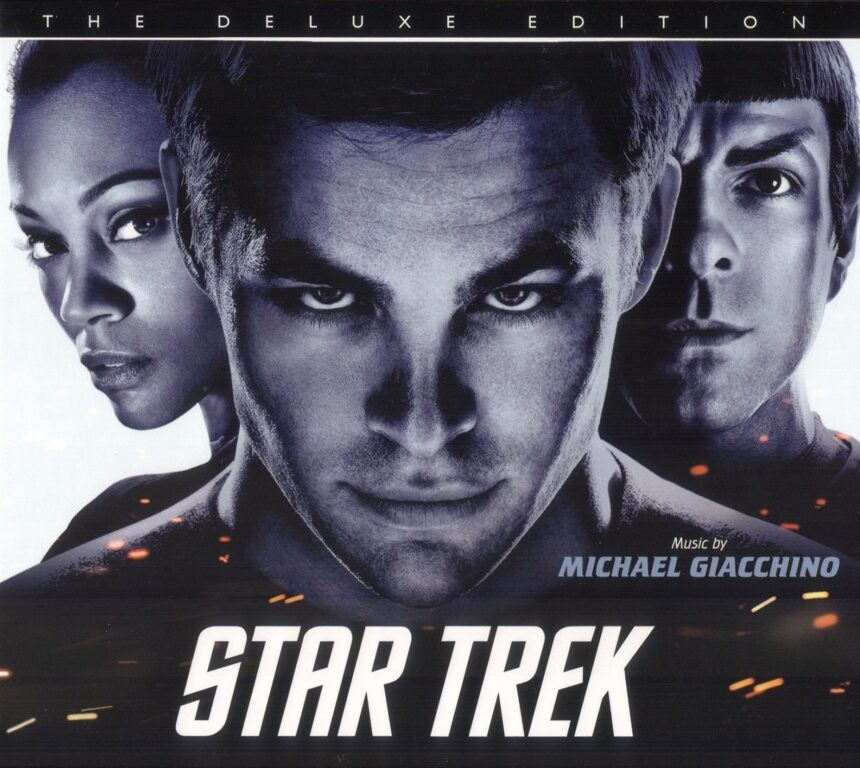
Bagman
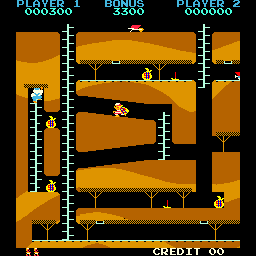 The Game: You’re a thief trying to make away with all the loot buried in a complex maze of interconnected mines and shafts, and you’d get away with it if it weren’t for some pesky cops who are hot on your trail. You can drop bags of money on them from a level above, or temporarily brain them with a pick, and they’ll occasionally also bumble into open mine shafts of their own accord. In any of these events, they vanish for a little while to recover before reappearing. But any of these things will do you in too! (Stern/Seeburg [under license from Valadon Automation], 1982)
The Game: You’re a thief trying to make away with all the loot buried in a complex maze of interconnected mines and shafts, and you’d get away with it if it weren’t for some pesky cops who are hot on your trail. You can drop bags of money on them from a level above, or temporarily brain them with a pick, and they’ll occasionally also bumble into open mine shafts of their own accord. In any of these events, they vanish for a little while to recover before reappearing. But any of these things will do you in too! (Stern/Seeburg [under license from Valadon Automation], 1982)
Memories: Bagman was a very addictive and fun variation on the ladder-climing format that had become familiar in the space of just one year. Despite putting the player in the role of a crook, the worst behavior this game could possibly encourage would be slapstick, Keystone Kops-type violence (wouldn’t it be great if there were a bunch of comically clumsy cops, and wouldn’t it be great if they brought beer – really good beer?). It’s a very cute and playable game.
Pac-Man
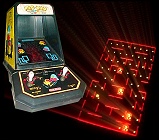 The Game: As a round yellow creature consisting of a mouth and nothing else, you maneuver around a relatively simple maze, gobbling small yellow dots and evading four monsters who can eat you on contact. In four corners of
The Game: As a round yellow creature consisting of a mouth and nothing else, you maneuver around a relatively simple maze, gobbling small yellow dots and evading four monsters who can eat you on contact. In four corners of  the screen, red power pellets enable you to turn the tables and eat the monsters for a brief period for an escalating score. The monsters, once eaten, return to their home base in ghost form and return to chase you anew. If cleared of dots, the maze refills and the game starts again, but just a little bit faster… (Coleco, 1981)
the screen, red power pellets enable you to turn the tables and eat the monsters for a brief period for an escalating score. The monsters, once eaten, return to their home base in ghost form and return to chase you anew. If cleared of dots, the maze refills and the game starts again, but just a little bit faster… (Coleco, 1981)
Memories: When Atari’s VCS translation of the immensely popular Pac-Man debuted to almost universal scorn, Coleco’s marketing division must have cheered. The market was primed for a good game of Pac-Man, and with the first in its line of licensed “mini-arcades,” Coleco had just the ticket every kid was looking for.
TI Invaders
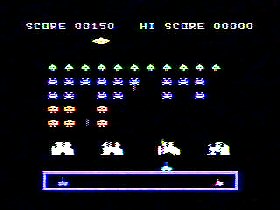 The Game: It’s quite simple, really. You’re the pilot of a ground-based mobile weapons platform, and there are buttloads of alien meanies headed right for you. Your only defense is a quartet of shields which are degraded by any weapons fire – yours or theirs – and a quick trigger finger. Occasionally a mothership zips across the top of the screen. When the screen is cleared of invaders, another wave – faster and more aggressive – appears. When you’re out of “lives,” or when the aliens manage to land on Earth…it’s all over. (Texas Instruments, 1981)
The Game: It’s quite simple, really. You’re the pilot of a ground-based mobile weapons platform, and there are buttloads of alien meanies headed right for you. Your only defense is a quartet of shields which are degraded by any weapons fire – yours or theirs – and a quick trigger finger. Occasionally a mothership zips across the top of the screen. When the screen is cleared of invaders, another wave – faster and more aggressive – appears. When you’re out of “lives,” or when the aliens manage to land on Earth…it’s all over. (Texas Instruments, 1981)
Memories: A straightforward, no-frills take on Space Invaders, TI Invaders trumped just about every other home computer version in terms of faithfulness to the source material.
Mouskattack
 The Game: Plumber Larry Bain is out to earn his hazard pay, trying to run pipes through a rat-infested maze. This wouldn’t be a problem, except that the rats are as big as he is. He can lay a limited number of traps in the maze that will temporarily stop the rats in their tracks so he can double back and eliminate them, but in the end Larry’s best chance of survival is to stay on the run and fill the maze with plumbing. (Sierra On-Line, 1981)
The Game: Plumber Larry Bain is out to earn his hazard pay, trying to run pipes through a rat-infested maze. This wouldn’t be a problem, except that the rats are as big as he is. He can lay a limited number of traps in the maze that will temporarily stop the rats in their tracks so he can double back and eliminate them, but in the end Larry’s best chance of survival is to stay on the run and fill the maze with plumbing. (Sierra On-Line, 1981)
Memories: Cut from the same “let’s do Pac-Man but make it different enough from Pac-Man that we don’t get sued” cloth as his own Jawbreaker, John Harris strikes again with Mouskattack, which was actually advertised as being “by the author of Jawbreaker,” which may be one of the earliest instances of a game being advertised as something that should be bought on the strength of that programmer’s previous works.